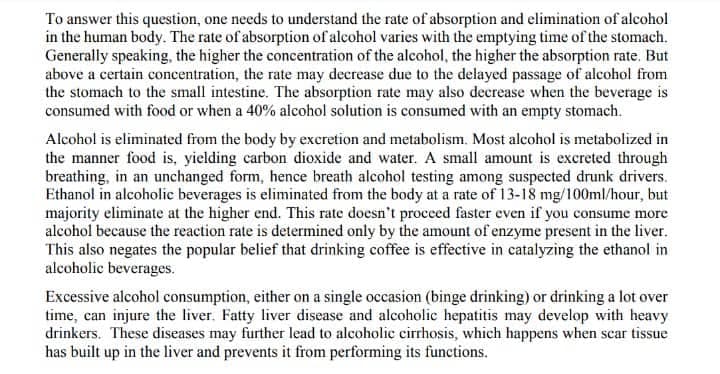read the passage and answer the question: - knowing the rate of absorption and elimination of etanol in the human body, how will you utilize this information to guard yourself against the habit of excessive or binge drinking?
read the passage and answer the question: - knowing the rate of absorption and elimination of etanol in the human body, how will you utilize this information to guard yourself against the habit of excessive or binge drinking?
Introduction to General, Organic and Biochemistry
11th Edition
ISBN:9781285869759
Author:Frederick A. Bettelheim, William H. Brown, Mary K. Campbell, Shawn O. Farrell, Omar Torres
Publisher:Frederick A. Bettelheim, William H. Brown, Mary K. Campbell, Shawn O. Farrell, Omar Torres
Chapter7: Reaction Rates And Chemical Equilibrium
Section: Chapter Questions
Problem 7.42P
Related questions
Question
read the passage and answer the question:
- knowing the rate of absorption and elimination of etanol in the human body, how will you utilize this information to guard yourself against the habit of excessive or binge drinking?

Transcribed Image Text:To answer this question, one needs to understand the rate of absorption and elimination of alcohol
in the human body. The rate of absorption of alcohol varies with the emptying time of the stomach.
Generally speaking, the higher the concentration of the alcohol, the higher the absorption rate. But
above a certain concentration, the rate may decrease due to the delayed passage of alcohol from
the stomach to the small intestine. The absorption rate may also decrease when the beverage is
consumed with food or when a 40% alcohol solution is consumed with an empty stomach.
Alcohol is eliminated from the body by excretion and metabolism. Most alcohol is metabolized in
the manner food is, yielding carbon dioxide and water. A small amount is excreted through
breathing, in an unchanged form, hence breath alcohol testing among suspected drunk drivers.
Ethanol in alcoholic beverages is eliminated from the body at a rate of 13-18 mg/100ml/hour, but
majority eliminate at the higher end. This rate doesn't proceed faster even if you consume more
alcohol because the reaction rate is determined only by the amount of enzyme present in the liver.
This also negates the popular belief that drinking coffee is effective in catalyzing the ethanol in
alcoholic beverages.
Excessive alcohol consumption, either on a single occasion (binge drinking) or drinking a lot over
time, can injure the liver. Fatty liver disease and alcoholic hepatitis may develop with heavy
drinkers. These diseases may further lead to alcoholic cirrhosis, which happens when scar tissue
has built up in the liver and prevents it from performing its functions.
Expert Solution
This question has been solved!
Explore an expertly crafted, step-by-step solution for a thorough understanding of key concepts.
Step by step
Solved in 2 steps

Knowledge Booster
Learn more about
Need a deep-dive on the concept behind this application? Look no further. Learn more about this topic, chemistry and related others by exploring similar questions and additional content below.Recommended textbooks for you

Introduction to General, Organic and Biochemistry
Chemistry
ISBN:
9781285869759
Author:
Frederick A. Bettelheim, William H. Brown, Mary K. Campbell, Shawn O. Farrell, Omar Torres
Publisher:
Cengage Learning


Introduction to General, Organic and Biochemistry
Chemistry
ISBN:
9781285869759
Author:
Frederick A. Bettelheim, William H. Brown, Mary K. Campbell, Shawn O. Farrell, Omar Torres
Publisher:
Cengage Learning
